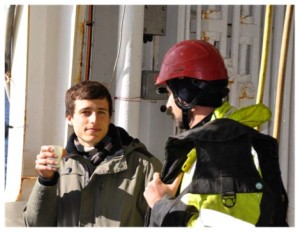by Casimir De Lavergne
RREX cruise: R/V Thassala
On June 6, 2015, I embarked with the RREX team on R/V Thalassa for a five-week journey across the subpolar North Atlantic. The ultimate objective of the cruise is to fathom the mysteri es of ocean flows near the Reykjanes Ridge, a submarine mountain chain connecting the southern tip of Iceland to the Mid-Atlantic Ridge further south. Though achieving this goal will remain a continuing challenge for the months and years to come, some distance has certainly been covered. A huge amount of information on local currents, turbulence and water properties has already been collected, and much more data is to be recovered from the vast array of autonomous instruments that have been deployed. Promisingly, preliminary (real time!) analysis of the data already shows some intriguing and unexpected features. The next step will be to build an understanding of the underlying physics by comparing the new data to historical observations, laboratory experiments and theory.
es of ocean flows near the Reykjanes Ridge, a submarine mountain chain connecting the southern tip of Iceland to the Mid-Atlantic Ridge further south. Though achieving this goal will remain a continuing challenge for the months and years to come, some distance has certainly been covered. A huge amount of information on local currents, turbulence and water properties has already been collected, and much more data is to be recovered from the vast array of autonomous instruments that have been deployed. Promisingly, preliminary (real time!) analysis of the data already shows some intriguing and unexpected features. The next step will be to build an understanding of the underlying physics by comparing the new data to historical observations, laboratory experiments and theory.
But for a student living its first embarkation, such a cruise holds many more lessons than those coming from the data itself. Now barely ten days away from the ship’s docking in Brest, let us venture a brief assessment.
By observing the crew and team members unpacking, packing, unpacking again and finally launching nine different moorings, I learned how much energy, preparation and patience are required to deploy moored instrumentation in the deep sea.
By discussing with designers of oceanic robotic floats, I learned how much engineering hides within an Argo float.
By following the sixty ups and downs of a microstructure profiler, I learned what it takes to measure the dissipation rate of kinetic energy in the ocean.
By spending over fifty four-hour shifts performing CTD-O2 (conductivity-temperature-depth-oxygen) casts, I learned where our historical knowledge of the planet’s oceans comes from.
By waiting hours to days for the sea to calm down before resuming measurements and deployments, I learned how much oceanographers depend upon meteorologists.
By realizing how many different fields of expertise must meet and cooperate to build and implement oceanographic instrumentation, from electricians to chemists through seamen, I got to appreciate the human achievement such a project represents.
I learned that in-situ oceanic data deserves respect.
By looking over and over at the meteorological forecasts only to see our ship being hit by yet another North Atlantic low pressure system, I learned what “storm track” means.
By observing our Chief Scientist designing and re-designing our strategy, positioning and re-positioning observational points, consulting and re-consulting the captain, I learned that leading a field campaign requires fast decision-making given constantly evolving parameters.
By cohabiting and exchanging with crew members, I learned about the world of sailors.
I also learned about paleontology. By enduring the ship’s endless movements, by measuring the million situations in which we are accustomed to evolve on stable ground, I learned that the human species definitely developed on land.
By taking part to the RREX cruise, I learned how important it is for a student in oceanography to go out at sea and actually see.